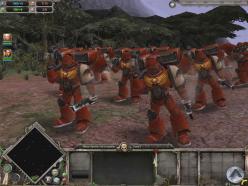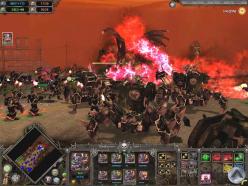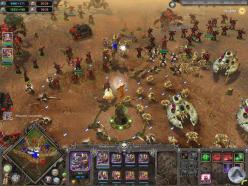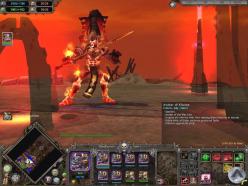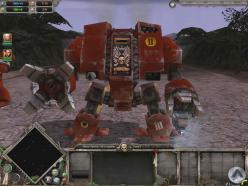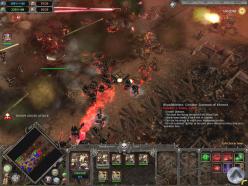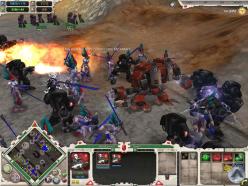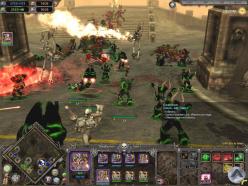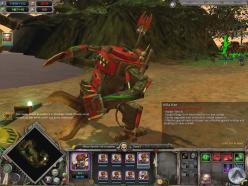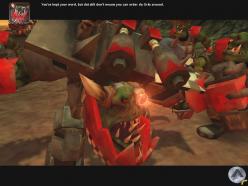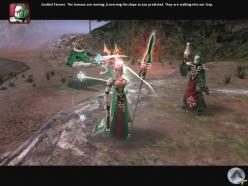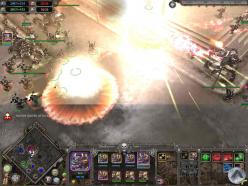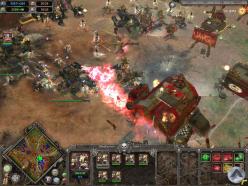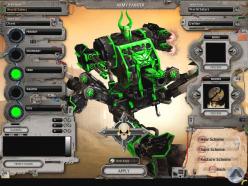WARHAMMER 40,000
![]()
|
|
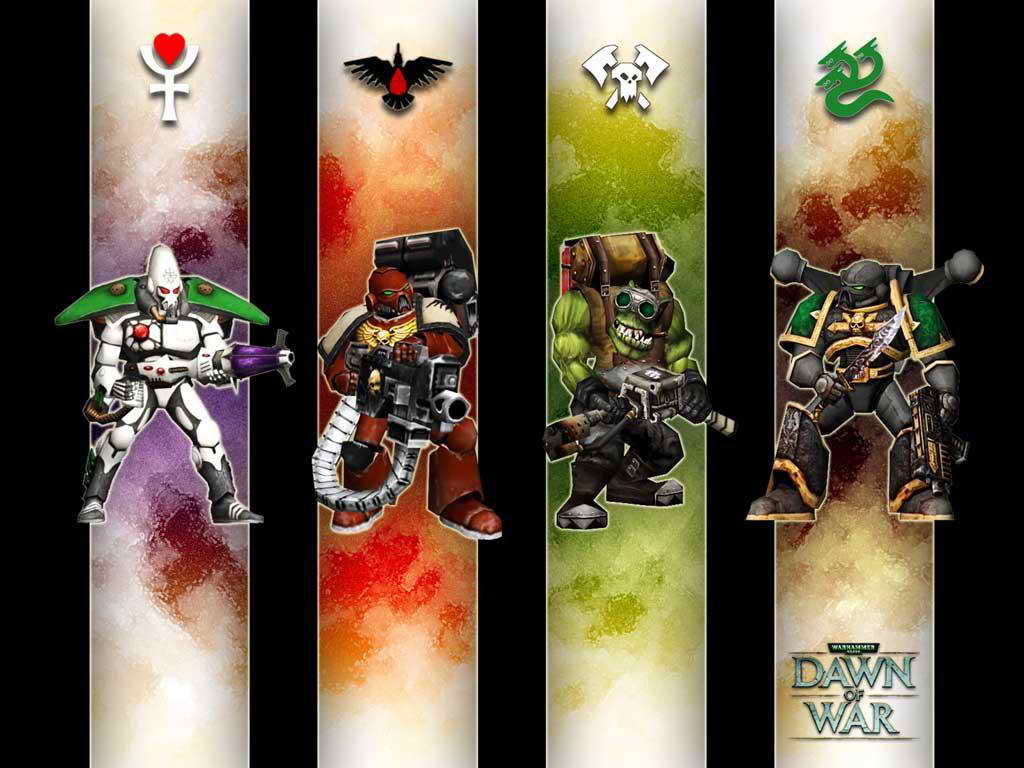 |
||||||||||||
| Posted:2006-03-21 By Master Chief Number of View:26579 |
|||||||||||||
By :Master Chief Posted:2006-03-21
Warhammer 40,000: Dawn of War Publisher: THQ Developer: Relic Genre: Real-Time Strategy ESRB: Mature System Requirements 1.4GHz CPU, 256MB RAM, Windows 98/ME/2K/XP, 32MB 3D Accel. “Through man\'s existence, from the start of time; The fight for survival is our only crime.” -Bolt Thrower, “Eternal War”
As epic as it is brutal, the flagship product of the The full history and mythos behind Warhammer 40K is entirely beyond the scope of this review; it’s incredibly detailed and rich. Indeed, my interest in it is deeply rooted in the fantastic fiction behind the game itself, more so by far than painting the miniatures. To attempt to give a rough overview, we need to look at how far in the future Warhammer 40K (and Dawn of War) takes place. The name is a small clue: It is the 41st millennium and humanity has moved somewhat past the Milky Way. Mankind is ruled by the iron psionic fist of the Emperor, considered a living god and long since ensconced in a massive life-support tomb. The more things change, the more they stay the same; we are still an incredibly expansionist species and the Emperor is the backbone that supports the constant push to take in more and more worlds. Of course, we aren’t alone, and other races might not be so pleased to be overrun by hairless primates. Thus the stage is set for the cosmos-spanning perpetual conflict that is Warhammer 40K and Dawn of War. Savage, pseudo-primitive orks fight everything they see (including each other) with instruments cobbled together via duct tape, spit, copper wire, and an almost defiant sense of impossibility. No one knows how the orkish MekBoyz manage to make anything work, but they do to the detriment of everyone they encounter. The ancient and mysterious Eldar race has an agenda that often doesn’t work in concert with humanity, and from time to time the Emperor’s elite have to test their mettle against advanced warp technologies that were ancient when mankind was still living in caves. Finally, the forces of Chaos are continuously spilling out from the Eye of Terror, plaguing the universe with scores of warped and twisted daemons, hate-fuelled Chaos Marines, and possessed machines. For the sake of brevity, I won’t touch on the further factions that are part of the Warhammer 40K universe (Tyrannids, Dark Eldar, the four Chaos Gods, etc). Dawn of War gives you Space Marines, Chaos Marines, Orks, and Eldar to work with in your efforts to crush all opposition. The cornerstone of all strategy games is the different approaches to victory each race uses, and Dawn of War is no different. While the Space Marines and the Chaos Legions tend to have similarities due to the fact that Chaos Marines were once members of the Emperor\'s forces, the comparisons end pretty much the moment you see their heavy anti-infantry mech units. (Dreadnaughts and Defilers are absolutely nothing alike.) The Orks and the Eldar are far more wildly disparate in how they annihilate foes, no mistaking them from the get-go. Dawn of War is cut from the same cloth as Starcraft and Warcraft III: you build up armies with varying capabilities in order to crush the similarly constructed forces of your enemies. To do this you need to construct different buildings that give access to new upgrades and abilities, as well as new units. To do all of this requires supplies, and so you must balance resource availability with attack and defend feints. There are some minor differences between Dawn of War’s approaches to the formula and the previously mentioned RTS heavy-hitters, though. For example, resource management is considerably simplified. There are only two things you need: requisition and power. The latter is self explanatory; build power generators to get more of it. The former is an abstraction of all raw materials you might need, and it trickles in all by itself. You don’t need to build worker units to harvest or collect requisition, however, to increase the rate it generates, you will need to capture and hold strategic points. This is essential, otherwise you’ll be sitting around while your opponent builds an army to wipe you out. Infantry play a more significant role in Dawn of War than I have personally ever seen in an RTS. The wide variety of different weapons you can research and equip them with is a massive part of the strategies you’ll develop to ensure victory. Flamers destroy morale; use them and you’ll see enemy squads break and flee frequently. Bolters are exceptional armor piercing weapons; they chew through other infantry quickly. Plasma weapons are inaccurate on the move, but make excellent ordinance against mechanized walkers like the Eldar Wraithlord or Orkish Killa Interestingly, there are no single units when it comes to infantry. All summoned troops come in squads, and can be reinforced up to a certain racial cap. For example, a squad of Space Marines comes in by default at four, and can be reinforced to a maximum of 10 (eight plus a sergeant and an attached special unit) after you’ve researched up the limit for the Marines. This is in contrast to the Orks limit of 17 units per squad. You can also research sergeant ranks, one per squad to increase morale. They have access to higher grade weapons like power-fists and chain swords that normal units don’t get, improving squad efficiency. Unique commander troops can also be summoned. These have access to the best weapons, enforce morale even more than sergeants, and usually have special abilities like Daemon Strength (for Chaos). Finally there are the special heavy units - walkers, tanks, and such. The armies of the Emperor have the widest variety of vehicles, as well as the most powerful. This is offset by certain massive creatures that the other races have access to. The Orks have the Squiggoth (a giant armored dinosaur), Chaos has the Bloodthirster Greater Daemon, and the Eldar have the Avatar of Khaine, their blood-handed god of war. All of these are rare on the battlefield, but deal frightening amounts of damage when called. Dawn of War was certainly designed with multiplayer in mind, however, there is a lengthy single-player campaign as well, that follows the tale of the Blood Ravens Space Marine Chapter and its pursuit of Chaos corruption and Orkish aggression. The missions that tie together the solo story are long and epic, each one feeling more or less the same as the final mission of Starcraft. One might think that a certain amount of burnout would occur with that much drama, but it just wouldn’t be Warhammer if every single battle didn’t feel like the war to end all wars. Sadly, you don\'t have the option of playing any of the other races in the solo mode, just the Blood Ravens. This provides all that much more reason to register your GameSpy account for some brutal online matches. Other than a few unique mechanics, the game plays out almost completely in tune with real-time strategy traditions. Graphics: The number one factor when dealing with a game as visually driven as Warhammer 40,000 is the graphics, and I’m quite happy to say Relic has gone far above and beyond the call of duty here. Dawn of War looks amazing, it runs smoothly, it’s flexibly scalable, and most importantly for fans of table-top Warhammer 40K, it’s faithfully accurate. No detail was sacrificed, no artistic license taken; everything is exactly as it should be in accordance with Games Workshop canon. Dawn of War starts off with a pre-rendered cinematic that is simply awe-inspiring. You’re pulled right into the thick of a desperate last stand of Space Marines against a massive horde of Orks, and there is no quarter asked for or given. This is as violent as intro movies get, and I honestly can’t recall the last time a single scene like this got me so completely on-board in less than two minutes. From there on, it’s all golden. There is a solid balance of high polygon counts, to detailed texture mapping that allows for convincing model renders that don’t annihilate the frame rates. Even at maximum settings, the only stutters you’ll see are in the middle of a three-on-three multiplayer game where all armies are at maximum capacity and are going the distance. Even then, with literally dozens upon dozens of troops on-screen spouting fire and plasma everywhere, the lag is negligible. At no point is a slideshow effect present, even though you fully expect it with the sheer numbers involved. Also, Dawn of War sports the best animations I’ve ever encountered in an RTS, with a galaxy of small details you don’t usually see in these games. If you zoom in and just watch your troops at ease, you can see them check their weapons, making sure the actions are smooth. In combat they actually reload mid-fight, initially making you nervous that perhaps they might run out of ammunition and then it\'s game over man, game over! Some of the various ways your squads die is horrible, in that “M for Mature” way that we all seem so addicted to. Concussive strikes will send your infantry flying through the air, Dreadnaughts grab individuals and literally snap their spine and toss them aside like bags of trash, and Bloodthirsters actually eat some of their foes alive. It’s not everyday you get to see stuff like that; it’s a pretty visceral experience. My only reservation in regards to the graphics lies in the texture detail of the backgrounds. Even when set at maximum detail, the terrain, flora, and building textures tend to look blocky and low-res when you zoom in really close. I love getting right into the thick of my armies when they’re at full strength, and I find it distracting that the illusion doesn’t hold up on close inspection. Interface: Dawn of War is, like most RTS titles, primarily a mouse-driven release. There are shortcut hotkeys, methods for quick-selecting squads and such, but the majority of your input will be merrily clicking away towards the destruction of your enemies. There are robust camera controls available, allowing you to get right down into the thick of battle. I personally found that I couldn’t pull my point of view out far enough, though; there were many times I wished I could see more of what was going on. It would make micro-management significantly easier if I could at least see my entire base, but the maximum viewing distance (at the resolution I played at) allows you to see about four buildings at a time before the need to scroll around. The screen real estate sported by Dawn of War seems at first to be quite intimidating, however, once you’ve gotten used to the icons and played through a couple of the single-player missions, everything clicks into place and feels very comfortable. There is a good balance of style and utilitarian sensibilities, with a robust mini-map in the lower left hand of the screen, squad information and reinforcement queues beside that, and command icons (stop, hold position, attack, etc.) on the right hand side. The top of the screen is a minimalist affair, with drop-down chat, diplomacy, objective, and options menus on the right side, and numerical readings for your requisition and power on the left. With the exception of not being able to zoom out far enough, I found the interface quite elegant. Gameplay: If you are even somewhat conversant in the RTS genre, you’ll feel almost immediately at home with Dawn of War. Even if you’re new to the idea of these games, it’s still user-friendly enough to quickly adapt to. The tutorial is comprehensive and easy to digest, feeding you just the right amount of information to absorb and familiarize yourself with before moving on to the next step. It’s highly unlikely that you’ll ever feel like you’ve missed something. The question after this is what kind of fun does Dawn of War have to offer? The answer can be summed up in one word: tons. I have to be completely honest here, I haven’t had this good of a time playing an RTS in years. The single-player campaign isn’t exactly the most re-playable I’ve ever seen, mostly due to the fact that it only follows the Space Marines. There are also some minor pathing issues that need to be wrestled with, but the storyline is engaging enough to keep you going until you graduate to the significantly more complex multiplayer element of Dawn of War. As I previously mentioned, somehow Relic managed to make every mission feel like the grand finale of Starcraft; that’s a pretty impressive feat. Also, if you don’t feel like slogging through the campaign, and you don’t have access to the Internet or feel like coping with strangers, there is a quick-action skirmish mode that simulates the online experience without the need to connect. (Ed. Note: It\'s been pointed out to us by several readers that buildings/units are, in fact, destructable by using the delete key. As a result, we\'ve revised the score for this criterion upwards.) Multiplayer: This is easily the strongest aspect to Dawn of War. It absolutely shines as a multiplayer title, offering full access to all four races and opening up the full possibilities for strategy this release packs under the hood. The browser and chat system is powered by GameSpy, and implemented far more efficiently than say, Star Wars: Battlefront. Log in, find a chat room, and browse matches at your leisure. Or create your own: set the map, number of players, victory conditions (annihilate is the most frequently used), AI difficulty, and resource development. Everything is self explanatory. You can also use a quick-action feature, setting a few standards such as 1-vs-1, 3-vs-3, etc, and the system auto-matches you with others for a no-muss, no-fuss method of playing against others. The net code here is solid; lag has yet to be an issue for me. As a matter of fact, the only real criticism I have lies in racial balance. As it stands right now, Space Marines require the least effort to use but also pack the greatest ordinance. The two capabilities that are the most imbalanced right now are Dreadnaughts and Orbital Strike. The former is easy to attain, quick to spawn, and requires far more firepower to take down than any other heavy armor. The latter has no Achilles\' heel save for cost, and can obliterate the majority of an enemy base with no risk to the commander of the Space Marines using it. Pound for pound, a talented Space Marine player against equally talented Chaos, Eldar, or Ork players will see the Space Marines victorious every time. However, let it not be said that these issues aren’t being worked on, and are so overwhelming that they make the online experience unpleasant. I enjoyed the single-player mode immensely and I absolutely love the net matches. Given my choice between the two, I’ll recommend the multiplayer every time. Sound FX: Relic did an admirable job with the sounds in Dawn of War, with only a few setbacks. The effects are complete, and nothing is lacking audio: At no point will you see a heavy bolter go off silently. The voice acting is robust and well executed; animated and quite full of character and charisma. The squads and various units like tanks, armored walkers, and unique leader types all have an array of different phrases they say whenever given a command or when selected. I would love to have seen more variety here, but there is at least enough that it isn’t maddening to click on a given squad. Some of the voice acting lies somewhat on the cheesy side: The Ork\'s Gretchin workers all sound almost identical to Gollum, and the Chaos Cultists are so whiny that you find they make great cannon fodder, if only so that you don’t have to hear their weasel-like proclamations of how great Chaos is. The vast majority of the actors are excellent though. The only other issue I have with the audio design is that everything comes across as too quiet. Even pushed to maximum volume in the options menu you’ll still fine a lack of real punch. Heavier normalization or compression would have been most welcome here. Musical Score: The music score is high quality, consisting of bombastic orchestral pieces that are very "Hollywood-action-film" in mood and feeling. Think of the kind of music you would hear in a movie set on a slave-galley, that’s a little bit what the music in Dawn of War sounds like. Oppressive, yet gravely dramatic in accordance with the gravity of the situations it’s written to accompany. If there’s any one drawback to the score, it’s that it tends to pass in one ear and out the other - none of it is catchy enough to stick in your head. The music serves its purpose as ambient background ear-dressing, but beyond that it’s somewhat too neutral for its own good. Intelligence & Difficulty: The AI in Dawn of War is a mixed bag. To begin with, there is a clear difference between the AI in the campaign missions and the AI in the skirmish or multiplayer missions. In the single-player mode, you’re mostly dealing with scripted events, triggered by your progress. Beyond that, all you really need to worry about is a steady trickle of squads running higgledy-piggledy into your line of fire. It’s not clever, it’s rarely effective, but it does serve to keep you entertained while you build up a large enough force to go traipsing all over their base with your hordes. Skirmish and Multiplayer AI is a whole different matter, at least as soon as you set it to Hardest or Insane. Once you’ve decided to punish yourself with these settings, the AI picks up the pace. It exhibits significantly more aggressive techniques, including lateral-thought tactics (attack feints to weaken defense, pincer-move offenses, etc.) and adaptive reactions to your strategies. Of course, to do this it cheats (never fear folks, Relic gleefully admits the вЂ˜insane’ AI cheats). This unfair advantage comes in the form of knowing what direction you’re taking your infantry: if you lean towards anti-armor troops, you’ll get nailed by masses of close-quarter warriors; if you equip troops with tons of Flamers, you can expect lots of tanks to come steamrolling over your settlements. The computer knows at all times what it needs to be your worst nightmare. It’s also way quicker at instant requisition / power / tech-tree management than any human could ever be. The fact is, if you set the AI to insane, you know exactly what you’re getting into. You take it as a given that it’s going to be using dirty pool that you have no access to and thus you’ll have to be 200% more on the ball than normal. To put this into some perspective, two online friends and I went three-on-one against an insane AI and got soundly thrashed. Did it bother us? No, because we knew from the outset the word "insane" isn’t used lightly. It really is insane, and it’s incidentally loads of fun trying to beat it. There is a certain comfort in knowing there is always going to be significant challenge available to play against. Even taking into consideration the liberties taken by the AI, I’m quite impressed by the sophistication it displays when set to higher difficulty levels. Overall: As a general rule, I have weak multitasking skills. This means that I can rarely appreciate RTS titles because I’m too busy wallowing in misery just trying to figure out what’s going on in time to not get annihilated by three worker units sent my way as a humiliation technique by those I’m playing against. I say this to help provide a clearer sense of how good Dawn of War really is. It is so well crafted that it transcends my usual blocks, and is arguably the most fun I think I’ve ever had playing this style of game. It’s beautiful, it’s easy to use, difficult to master, and extremely replayable. Incidentally, it is also the best adaptation of Warhammer 40,000 yet put to code. For anyone who loves real-time strategy, this is a superb addition to your collection. For anyone who is unfamiliar with the genre, it’s an excellent starting point. For fans of the Warhammer universe, Dawn of War is a must-have.
we would be happy to answer for your question . if you have suggestion or comment
regarding this review our support would be glad to help just join our forum and ask u will get the best answer
to discuss check our forum section :-) RATE THIS REVIEW | |||||||||||||
![]()

7600gt review
7600gt is the middle card range.
We already benchmarked this video card and found that ...

 geforce 8800gtx and 8800gts
geforce 8800gtx and 8800gts  Xtreview software download Section
Xtreview software download Section  AMD TURION 64 X2 REVIEW
AMD TURION 64 X2 REVIEW  INTEL PENTIUM D 920 , INTEL PENTIUM D 930
INTEL PENTIUM D 920 , INTEL PENTIUM D 930  6800XT REVIEW
6800XT REVIEW  computer hardware REVIEW
computer hardware REVIEW  INTEL CONROE CORE DUO 2 REVIEW VS AMD AM2
INTEL CONROE CORE DUO 2 REVIEW VS AMD AM2  INTEL PENTIUM D 805 INTEL D805
INTEL PENTIUM D 805 INTEL D805  Free desktop wallpaper
Free desktop wallpaper  online fighting game
online fighting game  Xtreview price comparison center
Xtreview price comparison center 

- The new version of GPU-Z finally kills the belief in the miracle of Vega transformation
- The motherboard manufacturer confirms the characteristics of the processors Coffee Lake
- We are looking for copper coolers on NVIDIA Volta computing accelerators
- Unofficially about Intels plans to release 300-series chipset
- The Japanese representation of AMD offered monetary compensation to the first buyers of Ryzen Threadripper
- This year will not be released more than 45 million motherboards
- TSMC denies the presentation of charges from the antimonopoly authorities
- Radeon RX Vega 64 at frequencies 1802-1000 MHz updated the record GPUPI 1B
- AMD itself would like to believe that mobile processors Ryzen have already been released
- AMD Vega 20 will find application in accelerating computations
- Pre-orders for new iPhone start next week
- Radeon RX Vega 57, 58 and 59: the wonders of transformation
- ASML starts commercial delivery of EUV-scanners
- The older Skylake processors with a free multiplier are removed from production
- Meizu will release Android-smartphone based on Helio P40
- AMD Bristol Ridge processors are also available in American retail
- The fate of Toshiba Memory can be solved to the next environment
- duo GeForce GTX 1080 Ti in GPUPI 1B at frequencies of 2480-10320 MHz
- New Kentsfield overclocking record up to 5204 MHz
- Lenovo released Android-smartphone K8



computer news computer parts review Old Forum Downloads New Forum Login Join Articles terms Hardware blog Sitemap Get Freebies

